



“In The Treaty of Finsbury Park 2025, we are catapulted several years into the future where all the species of the park have risen up to demand equal rights with humans. After much unrest, it has been agreed that a treaty will be drawn up, designating these rights, but first humans must learn to better relate to and understand non-humans so they can cooperate better together. Thankfully there has been a new invention – The Sentience Dial – which allows humans to tune into all the flora and fauna of Finsbury Park.”
The Treaty of Finsbury Park 2025 is a collaborative project that depicts the story of the dawning of interspecies democracy. It’s a new era of equal rights for all living beings, where all species come together to organise and shape the environments and cultures they inhabit, in Finsbury Park (and urban green spaces across the UK, the world, and beyond!) Like many urban parks, Finsbury Park is fraught with environmental issues from noxious gasses and traffic noises to governance struggles and financial sustainability. If colonial systems of dominance and control over living beings continue we all face an apocalypse.
Based around a set of LARPs – or live action role play games – the Treaty of Finsbury Park 2025 is played from more-than-human perspectives to encourage the blooming of a bountiful biodiversity and interspecies political action. Think like a dog, bee or even grass and help change the way we all see and participate in our local urban green spaces forever.
There are 3 parts to the story.
Part 1. 2022. The Interspecies Assemblies – these are games where everyone gets to plan the Interspecies Festival of Finsbury Park 2023 – an event which will celebrate the drawing up of the treaty itself.
Part 2. 2023. The Vote – once artists have had a chance to gather everyone’s input they’ll present 3 proposals for the Interspecies Festival and everyone will be invited to choose the one they want to participate in.
Part 3. 2023. The Interspecies Festival of Finsbury Park – all the species of Finsbury Park will be invited to join the festival in Summer 2023.
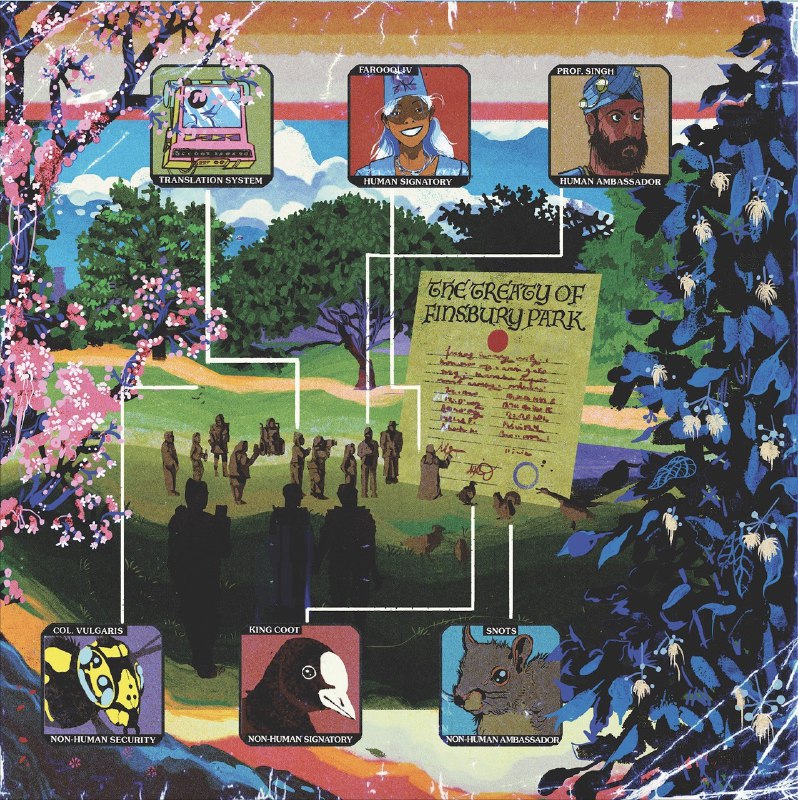
The Interspecies Festival will be a gathering for all species to showcase their cultures, their interests and talents. Like a World’s Fair or an Olympic Games, it will be a place of discovery, marvels and broadened horizons. But it can only be planned if you help all the species of the park present their ideas.
By planning the Interspecies Festival together, human people from the locality and around the world will build empathy pathways to other beings. They will learn about what matters to them and their habitats. They will explore what it would mean to acknowledge the equal rights of more-than-human beings to the same range of freedoms they expect for themselves. They will draft the Treaty and they will decide how to connect even more deeply with all the species of the park through a festival for all. From September 2022 scannable hoardings will wrap the Furtherfield Gallery in Finsbury Park with an exhibition featuring stories about the new knowledge and relationships formed by assembly members for the benefit of biodiversity locally and world wide.
In the PUBLIC game of ‘Interspecies Assemblies’, human players will be partnered with a mentor representing one of 7 species based in Finsbury Park. These include a tree, a bee, a goose, grass, a squirrel, a stag beetle and a dog. Players will be tuned into the mentor’s needs and experiences1 and will then represent them at a series of online assemblies being held to choose the events and the location in the park for the first ever Interspecies Festival of Finsbury Park.
PLAY THE INTERSPECIES ASSEMBLIES GAMES ONLINE.
RECEIVE UPDATES ON THIS PROJECT.
In Spring 2022 The Interspecies Artists Forum will be commissioned to design a set of festival activities for 3 biodiversity habitats based on everything learned and proposed through the Assemblies. For example, the dogs might lead on the Sniffathon followed by Barkeoke, Name that Honk for the Geese, and the Squirrels present the Antique Nut Show. Different activities for different habitats will then be presented as immersive scenes for mobile phones for a public vote.
There will be a PUBLIC vote to decide which biodiversity habitat in the park will host the festival, based on the interspecies activities designed for it. We already know that the bees are abuzz for the wildflower meadows, the stag beetles dig the ancient forest, while the squirrels squeak for the new forests. But the winning habitat will need to appeal to all the species. From April 2022 scannable hoarding will wrap the Furtherfield Gallery in Finsbury Park. Everyone – human or otherwise – is invited to attend, scan, and explore activities in the proposed habitats and decide where the Interspecies Festival should be held to best serve the bountiful biodiversity of the park.
The final Interspecies Festival activities will take place in the chosen habitat to be further developed and enjoyed by the park’s public in the summer. These will take place alongside the presentation of the draft Treaty for discussion by all the human and more-than-human people of the park.
Read the concept paper here.
RECEIVE UPDATES ON THIS PROJECT.
The Treaty of Finsbury Park 2025 is a major new project exploring new ways to build empathy pathways to non-human lifeforms through play.
It represents a major undertaking to do long-term work exploring how an arts organisation based in the heart of an urban green space can support a deeper understanding of that green space and ALL its inhabitants. Beginning in 2020 and spanning a minimum of 5 years, the work was originally developed in a collaboration between Furtherfield and The New Design Congress. The first 3 years are being supported by CreaTures Creative Practices for Transformational Futures. CreaTures project has received funding from the European Union’s Horizon 2020 research and innovation programme under grant agreement No 870759. The content presented represents the views of the authors, and the European Commission has no liability in respect of the content.
Artistic Direction by Ruth Catlow
Concept by Cade Diem and Ruth Catlow
Visual design by Cade Diem
Illustrations by Sajan Rai
LARP Design and Hosting by Ruth Catlow, Bea Xu and Max Dovey
LARP Player Assistance by Yejide Cordner
LARP Player Support by Lekey Leideker and Tanya Boyarkina
Writing by Ruth Catlow and Dr Charlotte Frost
Music by Matt Catlow
Digital Mask animation by PopulAR
Research by CreaTures, stewarded by Dr Lara Houston and Dr Ann Light
Production support for prototype LARPs by Tanya Boyarkina
Outreach for prototype LARPs by Pita Arreola
Thanks to our first players: Shawn, Carien, Anne, Tom and Ricard.
Special thanks to Ricard, Finsbury Park Ranger for introducing us to all the different lives of the park
Thanks to all online Interspecies Assemblies players – you know who you are – 🐶 WOOF!
Join us for the workshop that is also a game where we use roleplay to explore how personal and collective data practices and devices might shape the attitudes and fortunes of a society?
Sign up by 12th August 2020
Participants will each receive one of two devices in the post, and will be given different roles to play as delegates in a fictional trade negotiation. In this first meeting on record, and with minimal knowledge of each other’s cultures, the people of Ourland and New Bluestead must use their devices to communicate with each other and to agree to the terms of a technology and data-culture exchange.
What do they have to offer? How will they decide what they want and what is in their best interests?
What freedoms might they sacrifice, what insights might they gain?
How might they adapt a foreign technology to their own needs, and how might they understand the risks involved?
This is an invitation to participate in Transcultural Data Pact, a research event that is also a game of serious make believe. We welcome you to a future-historic event and clash of data-cultures.
The event will take place online in Zoom and will last for about 3 hours with a lunchtime pre-event orientation session that will last for an hour.
There are two sessions available for both the game event and the pre-event orientation (which is a requirement of participation):
Lunchtime pre-game orientation events
13.30 – 14.30 BST Tues 18 August 2020
13.30 – 14.30 BST Wed 19 August 2020
Transcultural Data Pact Game events
13.15 – 16.30 BST Thurs 20 August 2020
13.15 – 16.30 BST Fri 21 August 2020
In exchange for your time you will exercise your creative agency contributing to the ideation of future technologies for live personal data. You might even discover new meanings in your personal data in places you never thought of looking before!
All participants will receive a £20 voucher for their contribution to the research.
This is an open invitation to all. No experience in role-playing games is necessary.
Pregame orientation events
13.30 – 14.30 to learn about your devices and about LARPing, to introduce and develop the scenarios, to build the fictional worlds together.
Game Event Schedule
13.20 – 13.30 Arrive in Zoom and sign in
13.30 Introduction
13.40 – 16.00 Nations Technology Exchange Live Action Role Play
16.00 – 16.30 Debrief, reflection and survey
For any enquiries, please email ruth.catlow@furtherfield.org
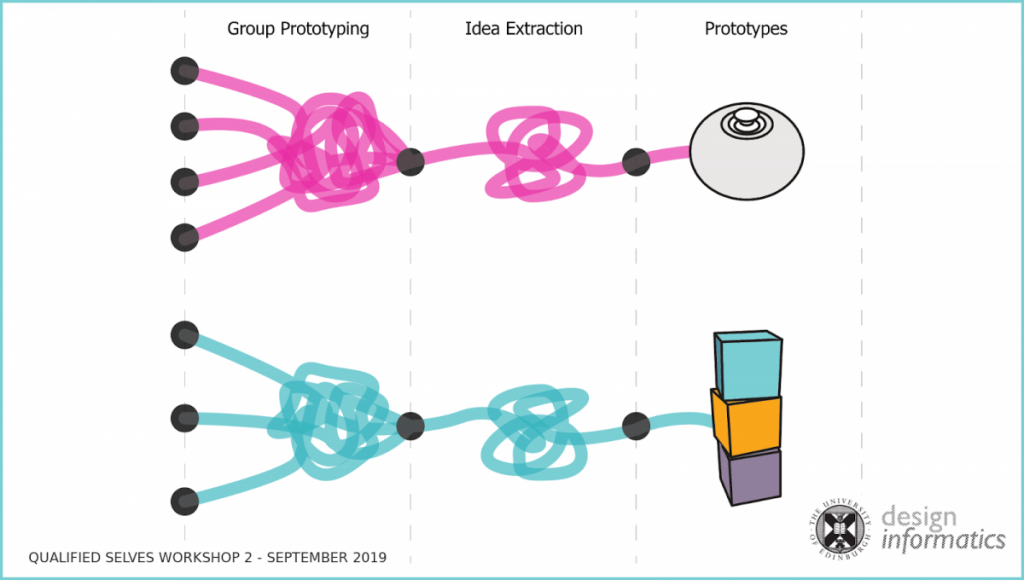
Findings contribute to a research paper Human-Computer Interaction (CHI).
The Transcultural Data Pact is a Qualified Selves research event that uses data objects to stretch people’s imagination about the collection and usage of their own data to investigate personal and collective data devices and practices that add real value.
Qualified Selves is a joint project between Lancaster and Edinburgh Universities. Improving how individuals make sense of data management (from social media to activity trackers to home IoT devices) in order to enhance personal decision making, increase productivity, and improve their quality of life. Its novel approach to co-design and co-creation has supported the development of new prototypes to help think about tracking data in different ways. https://sensemake.org/
Transcultural Data Pact is created by Ruth Catlow (Furtherfield/DECAL) with Dr Kruakae Pothong, Billy Dixon, Dr Evan Morgan and Prof. Chris Speed from Edinburgh University, in collaboration with Kate Genevieve.
Ruth Catlow is Director of DECAL. Furtherfield is London’s first (de)centre for digital arts. DECAL is a Furtherfield initiative which exists to mobilise research and development by leading artists, using blockchain and web 3.0 technologies for fairer, more dynamic and connected cultural ecologies and economies.
What would you do if your partner was spending 17 hours a day online to earn a living? This short dystopian fiction by Elliott Burns paints an unsettling vision of a Gamer/YouTuber’s life(style) slipping out of control…
posted February 22nd 2017
“Wow, just WOW everyone! So I’ve got some really big news I want to share with you… Earlier today, after I finished my lunch, Kung-Pow Chicken Sub by the way, I went into my boss’s office and calmly explained that I would be leaving the company. So I am now t-minus two weeks until I walk out those doors for the last time EVER.
Why am I doing quitting? Because of YOU! Because of everyone out there who follows this channel, who watches these videos, who makes up this community. After 3 years posting video after video after video, this channel now makes enough in YouTube advertising revenues for me to dedicate my life to it!”
[he holds a wireless webcam with his right hand; raised up it faces back towards him and the room, behind are drawn curtains, shelves of video games and collectable figures, his computer set up and a pro-gaming chair.]
“I want to say a huge thank you to everyone of you! This is a dream come true, for me, my wife (going on 6 months now guys), and our puppy.”
[crouching down with his left hand he raises a small fluffy dog to his chest.]
“Say “hi” Jasper, say “hi” to everyone. Jasper’s really happy that Daddy gets to stay home all day now and doesn’t need to leave him alone. You know what else it means… it means from today onwards I’ll be posting more videos, more of the content that you LOVE, like this:”
[the screen switches to footage of a plane pulling a barrel-roll over a middle-Eastern oil refinery; overlaid his voice can be heard erratically.]
“This is Goose Feet! OVER! Deploying payload,”
[just before the right-wing clips a tower, pulling to first-person perspective he is launched into the air, rifle in hand, screaming:]
“MAYDAY MAYDAY pilot down over enemy territory,”
[pulling his chute.]
“I’m going in hard, guns blazing, send EVAC NOW, this is not a drill, I repeat NOT-A-DRILL!”
[the screen switches back to him in his room.]
“Not to mention our times together…”
[now we see a squad of armour clad super soldiers charging up a hill, plasma blasts rain down overhead from multi-jawed aliens and explosions erupt either side; amongst the chaos and lighting-effects he’s heard reciting the Micky Mouse Club theme tune:]
“Who’s the leader of the club, That’s made for you and me, M-I-C-K-E-Y M-O-U-S-E,”
[as his team mates respond with burst of laughing and cries of:]
“SHUT THE F*** UP.”
[back in his room again he pants, physically exerted by his excitement.]
“But most important of all, it means I can dedicate more time, NAY, dedicate my life to showing off the best-of-the-best of your clips, the greatest examples of battle from all over the world! Every week I will be showing the most courageous, outrageous and outright insane feats of computer game brilliance that you send me. And each week you can vote on who is the greatest-of-the-great. The insanest-of-the-insane.
Because I LOVE you guys, I LOVE that you’ve invested in me, this channel, this community that we’ve built together. Keep the likes, the comments, the shares, everything coming. Follow me on YouTube, on Facebook, on Instagram. There’s going to be competitions, give-aways, constant non-stop banter-rific laughs…”
[his focus trails off slightly, pulling out of character before dropping back in…]
And of course, as always, my content is free to view. Subscribe and help me continue making this dream come true, and check out my online-store (link in the description below) for some excellent merchandise!
I can’t say how much this means to me. All your support, it makes my life worth living… So for now, until next time, PEACE OUT, SandCastle128.”
[the screen splits into 12 pieces showing a selection of related videos]

March 1st 2017 00:23am
Downstairs the kettle is whistling; it’s on the gas and there’s no sign anyone will take it off soon. His wife is asleep with the dog curled up by her feet. In ‘his office’ the glow of his monitor illuminates his face, providing enough light for the webcam to see him, yet leaving the background in darkness.
With his headphone-mic set he can’t hear the kettle. He won’t notice it until this round is over with either the terrorist or tactical-squad winning.
He’s entered the villa through an open first-floor window. Downstairs a firefight is breaking out as three teammates try to catch the terrorists in a pincer movement, breaching from the front and back entrances. He’s careful to avoid traps, they may have left explosive around any corner, or could be camping, waiting for him to make a mistake. Any second now his team should be able to identify how many hostiles are on the ground-floor; however, until then he’ll need to exercise extreme caution.
The fifth member of their squad is holding back, sniper scope poised to take a shot through any exposed window. It’s the third round and they’re two games down, the enemy are co-ordinated so they’re working to draw them out.
His teammates report comes in: “They’re all on the ground floor. SandCastle128, on my mark, assault from the main stairs.” A deafening volley of machine gun fire opens up, his HUD reports one target down, sniper fire takes a second. “GO GO GO.” He runs into the fight, catches two targets from behind, raises his shotgun to iron sight and pulls the trigger.
His wife smacks him round the back of the head. His shot misses and the targets turn filling him with lead. “Kettle’s boiled, I’m going back to bed!” That live-stream went out to 4,156 people on Facebook.
To read the rest of the story, please download Top 10 Plays of the Week as a PDF
The Road to Budgetary Blockchain Bliss, is a 2 hour Live Action Role Play adventure for the Blockchain-curious of all tribes including: hackers, lawyers, activists, artists, financiers, designers, venture capitalists, developers, marketeers.
Players adopt a fictional future version of themselves and work with others to solve a real-world problem. They learn about and build DAOs and Dapps (machine-based organisations and apps on the blockchain) and act out the social discomforts, asymmetries, dramas and politics of collaboration and coalition-formation across difference….starting with the budget!
NO PRIOR BLOCKCHAIN KNOWLEDGE NECESSARY
Fill out the application survey to ensure that you are assigned a compatible player character and so increase your chances of achieving your objective – fictionalise at will.
The Road to Budgetary Blockchain Bliss
Devised by Ruth Catlow, Furtherfield and Ben Vickers, unMonastery & Serpentine Galleries
WHEN?: Prompt start – 13:45 – 15:40 on Friday 2 Dec 2016
WHERE? The Presentation Room
As part of MoneyLab #3 Failing Better Symposium | Workshops | Exhibition,
Pakhuis de Zwijger, Amsterdam A two-day symposium,
1 – 2 December 2016, featuring talks, workshops and performances that confront the notion that finance is too big to fail.
Tickets: € 10 per session; € 30 per day, € 60 two day pass Students: 50% discount on all tickets
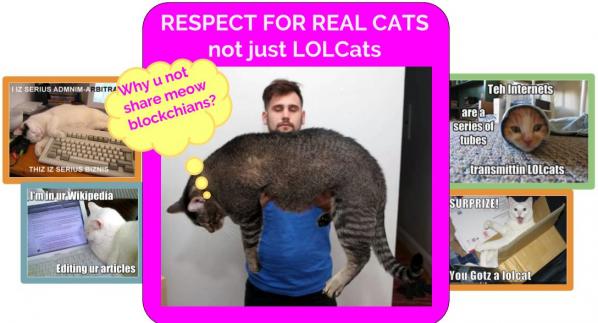
What is the relationship between state corruption and economic collapse in Greece?
Lina Theodorou, artist and creator of the board game ‘Pawnshop- Days of Mistrust’, talks with Furtherfield’s Ruth Catlow about Grexit, Brexit and crisis in Europe.
I met Lina Theodorou, the artist and creator of Pawnshop, in her apartment on a sunny Sunday morning in Berlin. It was just one week after the UK referendum resulted in a vote to leave the EU. I was in Berlin to take part in an event called Art, Money & Self Organization in Digital Capitalism, the first in a series of events called Arts and Commons, organised by Supermarkt.
Theodorou and I quickly got onto the topic of Brexit. We compared notes. She wondered if, like Greece, the UK government would choose to ignore the result of the referendum, fail to invoke Article 50, and stay in Europe after all. That possibility had not occurred to me. She talked about her memories surrounding the Grexit debate- the distress, the uncertainty, the shocking hatred and hostility expressed between family members and people previously considered friends. I had been deeply shaken by the upsurge of street-level racism on the streets of Britain.
Pawnshop, the artwork that is also a board game, was set up for play, laid out on a table in her studio. It is an inversion of Monopoly: the same square board, the pieces, the bank, the cards, the dice. However in this game the player starts the game with no money, only property – jewelery, a bouzouki, antique furniture, a flat- and pays a European tax of €1500 when they pass Go (if they get that far).

Players proceed around the board, according to the luck of the dice, along a path strewn with dilemmas. A second row of squares is used to keep track of the time spent dealing with the consequences of their choices- jail sentences, or hospitalizations for example. As they move around the board, they pick one of the cards, depending on their landing square, and must choose how they will respond to the given dilemmas.
Theodorou tells me that the game is based entirely in fact. For years she has collected newspaper stories in Greece. And here they are gathered in four categories of cards – Dilemma, Involvement, Debt and Luck- to encapsulate the experience of daily life, for everyone, in modern day Greece. ”If you are honest you lose” she says.
On her website are photos of engrossed players at Bozar, Center for fine arts, Brussels; at the exhibition TWISTING C(R)ASH; at Bâtiment d’Art Contemporain « Le Commun » in Geneva; and at the exhibition It’s Money Jim, but not as we know it, at Mario Mauroner Contemporary Art Vienna, and As Rights Go By, Museumsquartier, Vienna. She says it’s important that at the beginning players laugh… but because of ”synesthesia”, the longer they play, the more uncomfortable they become, they feel the ethical discomfort in their bodies.
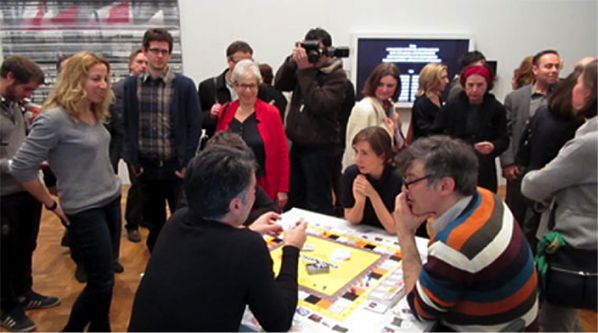
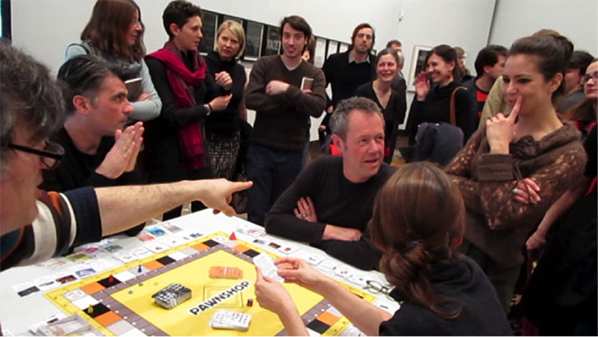
Theodorou and I digress again, coming back to the Europe question. Because I’m in Berlin I think about Germany’s role. Germany at the heart of Europe is perhaps more part of the problem than they realise. The style of bureaucracy is molded to reflect the German mentality and their industrial system.This is coupled with a confidence in the correctness of the system – that Theodorou points out, is accompanied by the Northern European, Calvinist attitude – anyone who does not comply is wrong and must be punished. “But what is good for Germany is not necessarily what is good for Greece” she says. In Greece for many years the economy was made up of many small entrepreneurs, small businesses, shops, and a community focus” Why must we suddenly give this up in favour of big business. “Why do you have to destroy something that is healthy?”After the banking crisis in 2008 pawnshops started popping up on every street in every town in Greece.
Theodorou tells me that Pawnshop is the Greek reality board game.
“Your father is sick, do you pay his hospital bill?
Yes: pay €3000 and he lives for another 6 years,
No: unfortunately he dies, but you receive a life insurance pay out of €75,000”
Picking an ‘Involvement’ card means that that player’s decision will have consequences for other people too; Debt (is the biggest pile of cards).
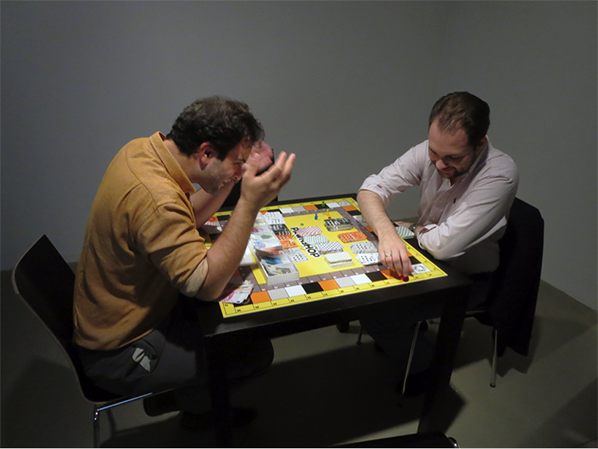
Gentrification strategies have failed in Athens. Back in 2006 the rich Greeks, many of whom were also art collectors, started to organise the large scale art events, (in which of course the artists worked for free), but it didn’t take. Then in 2008 the banks collapsed, the economy became surreal, but somehow, Athens remained the same. Perhaps this because regeneration does not have the ever-rising bubble of property prices to support its economy. In Greece everyday people do not speculate on the housing market (as we do in the UK). Rather a house is something you keep for ever in the family.
Theodorou describes the real world Greek tax system as “insane”. It changes every 3 months, Even the accountants have difficulty keeping up with the laws. This alone forces many people into the black market. Then the web of bureaucracy protects the hierarchical status quo and people in higher positions hold onto their power by putting obstacles in the way of others.
The only way to win this game (on the board and IRL in Greece) is with good luck. Good luck is the only way to avoid ethical discomfort or financial ruin.
The Luck cards (also based on fact as reported by the newspapers) are hilarious. “A politician hits you with her car, but fortunately the accident is witnessed by the media – collect €2500”.
“Some rich ladies wish you a Merry Christmas and hand you €100”.
Apparently Athens newspapers have reported tales, for the last few years, in which “ladies” have distributed money to “the poor” from black windowed limousines.

Pawnshop is a polemic on corruption. Small corruption. Long standing, Greek-style, everyday corruption from which no-one can escape. The universal, forced collusion in corruption, and its corrupting effect on the spirit of Greek citizens and society, is set out in the game mechanics. The playful and social medium of the game means that the impact of contemporary Neoliberal politics on the Greek ‘everyman’ is made legible, feelable and discussable: unending, ethical traps; the impossibility of old-style moral political clarity; the flushing of righteous action, solidarity, resistance or even survival. Corruption all the way up and down.
I question Theodorou carefully, because I have long been suspicious of the narrative that says that corruption is the cause of Greece’s economic problems. But the corruption is a fact. While it is not necessarily the only or even the primary cause of its economic distress – which is very very real- the lack of trust in the state is debilitating and has a stagnating effect on the economy.
Pawnshop sits in an honourable tradition of artist’s activist games: to change mindsets and attitudes by actively implicating players in a reconstruction of values – see Mary Flanagan persuasive research about crticial play and the many attitude-hacking games coming out of her lab Titlfactor. Also Brenda Romero’s chilling Train game, Yoko Ono’s Play it by Trust. And for games that train for resistance and solidarity in games such as Escape from Woomera, Debord’s Game of War, and my own pacifist chess hack, Three Player Chess.

A look around Theodorous portfolios of works reveals a long practice that crosses agitprop, video, installations, and networked pieces.
The work all builds on close observations of contemporary political and social systems. Through graphical exuberance and humour these observations are rendered just (barely) bearable so that we are able to spend time with complex, difficult situations and suspend our certainties. And this is necessary and important. We need to face the complexities and ethical contradictions of contemporary politics. There’s no time to lose.
Before the referendum, I found myself uneasy about actually campaigning for “Remain” in spite of my desire for a pan-European peoples’ alliance. This was because I couldn’t ally myself with the dominating political arguments proposed by the Conservative party (and backed up by big-business and the establishment). I also didn’t want to participate in a binary campaign that stamped on the dignity of the layer of people in the UK who are already so disenfranchised by the effects of austerity cuts (and many years of other systemic injustices). This moment revealed for me, and for many others in the ‘social liberal’ layer, a chasm between my own values and experience and those who voted to ‘Leave’. And a desire to find a way to connect. PostBrexit the reality board game may be just the thing we need to help us come together and play our way through the effects, consequences and possibilities.
Scratch is a programming environment that is easy to use and created with children in mind. Create and share your own interactive stories, games, music and art!
Codasign in partnership with Furtherfield will be running two Scratch workshops for children and their parents at Furtherfield Gallery on Saturday 13 April: a morning session with 6-9 year olds (10-12pm) and an afternoon one with 9-12 year olds (1:30-4pm).
Please book your place.
All supporting material for the workshop will be available at learning.codasign.com.
You will design and make a game or animation using the Scratch environment.
You only need to have big ideas – no other experience required.
You need to bring a laptop and an adult. The same adult can accompany multiple children. If you aren’t able to bring a laptop, just let us know by adding a note to your registration or e-mailing info@codasign.com.
There will be drinks available, but you are welcome to bring along some snacks to feed your creativity.
Full refund if registration is cancelled over a week before the course start, 50% if within a week of the course start, and no refund if within 24 hours of the course start.
VISITING INFO
Furtherfield Gallery
McKenzie Pavilion
Finsbury Park, London, N4 2NQ
Scratch is a programming environment that is easy to use and created with children in mind. Create and share your own interactive stories, games, music and art!
MaKey MaKey is a kit that lets you turn anything into a controller. Let your imagination go wild!
Codasign in partnership with Furtherfield will be running two Scratch + MaKey MaKey workshops for children and their parents at Furtherfield Gallery on Sunday 14 April: a morning session with 6-9 year olds (10-12pm) and an afternoon one with 9-12 year olds (1:30-4pm).
Please book your place.
All supporting material for the workshop will be available at learning.codasign.com.
During this workshop, the children will practice using computational thinking and interactive design in creative projects through a variety of activities. The adults will even play a key role in these activities.
You only need to have big ideas – no other experience required.
You need to bring a laptop and an adult. The same adult can accompany multiple children. If you aren’t able to bring a laptop, just let us know by adding a note to your registration or e-mailing info@codasign.com.
There will be drinks available, but you are welcome to bring along some snacks to feed your creativity.
Full refund if registration is cancelled over a week before the course start, 50% if within a week of the course start, and no refund if within 24 hours of the course start.
VISITING INFO
Furtherfield Gallery
McKenzie Pavilion
Finsbury Park, London, N4 2NQ
Scratch is a programming environment that is easy to use and created with children in mind. Create and share your own interactive stories, games, music and art!
MaKey MaKey is a kit that lets you turn anything into a controller. Let your imagination go wild!
Codasign in partnership with Furtherfield will be running two Scratch + MaKey MaKey weekend workshops for children and their parents at Furtherfield Gallery on Saturday 16 and Sunday 17 March: a morning session with 6-9 year olds (10-12pm) and an afternoon one with 9-12 year olds (1:30-4pm).
Please book your place.
All supporting material for the workshop will be available at learning.codasign.com.
During this workshop, the children will practice using computational thinking and interactive design in creative projects through a variety of activities. The adults will even play a key role in these activities.
You only need to have big ideas – no other experience required.
You need to bring a laptop and an adult. The same adult can accompany multiple children. If you aren’t able to bring a laptop, just let us know by adding a note to your registration or e-mailing info@codasign.com.
There will be drinks available, but you are welcome to bring along some snacks to feed your creativity.
Full refund if registration is cancelled over a week before the course start, 50% if within a week of the course start, and no refund if within 24 hours of the course start.
VISITING INFO
Furtherfield Gallery
McKenzie Pavilion
Finsbury Park, London, N4 2NQ
Scratch is a programming environment that is easy to use and created with children in mind. Create and share your own interactive stories, games, music and art!
MaKey MaKey is a kit that lets you turn anything into a controller. Let your imagination go wild!
Codasign in partnership with Furtherfield will be running two Scratch + MaKey MaKey workshops for children and their parents at Furtherfield Gallery on Saturday 23 February: a morning session with 6-9 year olds (10-12pm) and an afternoon one with 9-12 year olds (1-4pm).
Please book your place.
All supporting material for the workshop will be available at learning.codasign.com.
What will you do and learn?
During this workshop, the children will practice using computational thinking and interactive design in creative projects through a variety of activities. The adults will even play a key role in these activities.
What do you need to already know?
You only need to have big ideas – no other experience required.
What do you need to bring?
You need to bring a laptop and an adult. The same adult can accompany multiple children. If you aren’t able to bring a laptop, just let us know by adding a note to your registration or e-mailing info@codasign.com.
What will be available during the workshop?
There will be drinks available, but you are welcome to bring along some snacks to feed your creativity.
Cancellation Policy
Full refund if registration is cancelled over a week before the course start, 50% if within a week of the course start, and no refund if within 24 hours of the course start.
VISITING INFO
Furtherfield Gallery
McKenzie Pavilion
Finsbury Park, London, N4 2NQ
MaKey MaKey is a kit that lets you turn anything into a controller. Let your imagination go wild!
Codasign in partnership with Furtherfield will be running two MaKey MaKey workshops for children and their parents at Furtherfield Gallery on Saturday 16 February: a morning session with 6-9 year olds (10-12pm) and an afternoon one with 9-12 year olds (1-4pm).
All supporting material for the workshop will be available at learning.codasign.com.
What will you do and learn?
During this workshop, the children will practice using computational thinking and interactive design through a variety of activities.
What do you need to already know?
You only need to have big ideas – no other experience required.
What do you need to bring?
You need to bring a laptop and an adult. The same adult can accompany multiple children. If you aren’t able to bring a laptop, just let us know by adding a note to your registration or e-mailing info@codasign.com.
What will be available during the workshop?
There will be drinks available, but you are welcome to bring along some snacks to feed your creativity.
Cancellation Policy
Full refund if registration is cancelled over a week before the course start, 50% if within a week of the course start, and no refund if within 24 hours of the course start.
VISITING INFO
Furtherfield Gallery
McKenzie Pavilion
Finsbury Park, London, N4 2NQ
‘About 50% of global trade is channelled through tax havens and 83 of the 100 largest multinationals are based in the Netherlands for fiscal reasons. The flow of money seeks the path of least resistance – but where exactly do those paths lie today?’
This is how graphic designer Femke Herregraven began a presentation about her new online game Taxodus. Herregraven designed the prototype of Taxodus, a game about offshore tax avoidance, during a master class at Sandberg-Mediafonds. The offshore system offers companies advantages in countries where legislation relating to non-nationals guarantees certain privileges, for example, when it comes to corporate structures, in certain areas of business confidentiality, or low taxation. Taxodus is an accessible way to discover how you can avoid paying taxes, and if you can’t get away with it completely, how you can make sure you pay the lowest possible amount.
Annet Dekker: Taxodus is a game about offshore business practices. How does it work?
Femke Herregraven: As a player you choose an existing multinational company or bank with a specific profile and then you look for the most favourable countries to set up a subsidiary and accumulate income by paying as little tax as possible. Each country has a specific transaction profile. For example, companies involved with Intellectual Property Rights find the Netherlands most appealing, while oil companies are drawn to other countries. The game offers a random number of options and calculates what these yield for you. You can compare the results with other countries to achieve the game’s goal of reaching the end with as little expenditure as possible. The game is based on actual information on withholding tax in global tax treaties.
AD: This isn’t a topic you usually encounter in art. Where does your interest in this subject originate?
FH: In 2010 I was asked by the Virtueel Museum in Amsterdam to research the identity of the Zuidas during a residency. The Zuidas, which literally translates as ‘South Axis’, also known as the ‘Financial Mile’, is a large, rapidly developing business district in Amsterdam. Much like Richard Florida, they wanted to ‘cheer up’ the neighbourhood. My questions about the companies located there received only vague responses; there weren’t any lists, or names, or post boxes, and with the exception of known names like Google and Facebook, the other companies that are based there was a mystery. To trace what type of businesses might be located there I spent weeks indexing the entire Zuidas from the Chamber of Commerce’s trade register. I indexed the occupants by street and house number and then compiled three telephone books from the data. All sorts of unusual data and patterns became evident – some addresses only have one occupant, while others have more than a thousand of the so-called mailbox companies that only exist on paper. This is also apparent from the names: some only consist of Roman numerals.
All this information piqued my curiosity and I wondered why these companies were situated there and what they were up to. The next step was delving into Dutch tax law and it became clear that there are enormous financial benefits to setting up a company in the Netherlands. This is a major selling point when Holland is promoted abroad. The entire offshore system has operated below the radar for a long time – sometimes we catch a glimpse of it – but quite how it works in its entirety almost no one knows. The first step to understanding this is visualising it to gain insights, and then you can ask specific questions. Taxodus classifies this information by visualising it: from mining in the Congo to oil companies in Italy and Libya.
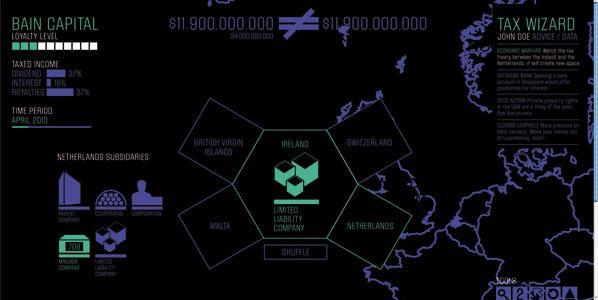
AD: It all sounds very murky!
FH: It’s all completely legal, but shady at the same time. If a foreign company doesn’t want to open a physical office in the Netherlands, it hires a trust office that takes care of the bookkeeping, drafts the annual reports and appoints a CEO. There are countless small trust offices that manage huge numbers of foreign companies on paper. Everything is done according to Dutch law and the tax benefits in Holland are hugely beneficial for foreign companies. For example, small businesses in the Netherlands pay more than thirty per cent tax, while foreign companies avoid a large part of that taxation due to tax planning. The presumption that foreign companies basing themselves in Holland is beneficial for national employment is also misleading because most of these companies only exist on paper and don’t employ anyone. The trust offices advise against opening a physical office and taking on any staff because Holland attaches great value to its employment policy, which makes dismissing personnel difficult. A ‘mailbox’ company avoids all these complications.
AD: But the way in which you visualise this is also subjective because you manipulate the data.
FH: Yes, I selected companies that people will know or which appeal to the imagination. Unfamiliar names won’t really be noticed, but once you realise that almost everyone participates in this system, from Mitt Romney’s Bain Capital, Walmart, Google and Facebook to Chanel, then it takes on a different immediacy or value for many people. If you look at this on a wider scale – globally – you will see, for example, that 60 per cent of large companies in Portugal, Italy, Greece and Spain use the Netherlands to take advantage of these types of constructions. This is legal and it’s also beneficial to the Netherlands, but when Dutch politicians insist on more transparency from Greece and lecture the country from up on high it smacks of hypocrisy. You see the same thing with a lot of development aid to countries in Africa: most of that money is diverted to the bank accounts of African leaders in offshore tax havens. Someone has done the maths: the debt of the entire African continent is less than the monies African leaders hold in offshore tax havens. A ‘mailbox’ company by itself is not that suspicious, but with everything else it creates the holes through which (public) money can disappear. My primary intention is to make these flows of money visible and question them, because once it’s out in the open people can decide for themselves if this is our idea of a sustainable economy.
AD: Of course, your game can also be interesting for existing companies who can use it to see where and how they can best invest? Is Taxodus the new Monopoly?
FH: Yes, in a way it is, but in reality companies have been doing this for ages. General Electric supposedly has a department employing about a thousand people who are busy with this on a full-time basis. I don’t think my game will suddenly improve things. Yet, the point is that the knowledge about international tax planning is now only in the hands of experts like fiscal lawyers and accountancy firms, and isn’t accessible to the rest of us. That’s also what Taxodus is about, making a tool so that we can track what they’re up to.
Monopoly is an interesting comparison because it originated as a critique of capitalism and private monopolies. The games are comparable, but Taxodus goes further. If you make a move in the game that correlates to reality then you are informed about this and receive a reality-bonus. It’s at this point in the game that investigative journalism comes into play.
AD: How do you relate to investigative journalism?
FH: My projects frequently begin from a journalistic position and for this one I meet with journalists, fiscal lawyers and researchers quite often. Yet, I’m a designer and I don’t want to write articles but use other methods to provide insights into topics. For me design is not an end in itself but a way to research, express and contribute to debates in society. This means also collaborating with other disciplines and experts: a group of fiscal experts is currently helping to remove errors and provide feedback. Obviously, it’s impossible to create a 1:1 translation, there will always be things that aren’t entirely accurate or that have to be left out, but it is important that the broad outlines are clear and correspond with reality.
AD: Why a game?
FH: Avoiding and evading tax is complex but you can learn the psychology of this system by playing the game. Taxodus is actually a kind of chess game. The rules aren’t simple and your eventual benefits depend on all sorts of interrelated factors. You have to continually take strategic decisions to advance in the game. All this information is incorporated into the game and the various tax treaties between different countries gradually become clearer. You are aided in this by advisors. At the start of the game you chose a particular advisor. Different advisors offer different advice, some will try to find legal alternatives while others try to convince you to bend the rules. Players can ask for a second opinion at any point in the game and manipulate regulations and treaties. This enables players to steer the game in the direction they choose. As in reality, a player has to have the possibility to have complete control. Ideally the game should be a do-it-yourself kit that you can add things to, an open game of strategy.
AD: What do you mean exactly? Can you name an example?
FH: The simplest way is to play it alone; the more complicated version is played with others in real time. At a certain point you can earn loyalty points by, for instance, evading high taxation for your parent company. Once you’ve arrived at the loyalty level, you can change roles, perhaps becoming a government employee who modifies regulations ever so slightly to make it more beneficial for yourself. You can also block other players in this way. This is an obvious reference to the increasing merging and blurring of the interests of large corporations and political leaders.
AD: How do you keep up with actual changes in the real world?
FH: It isn’t as if new information is constantly being made available – a lot of countries are reluctant or refuse to release ‘sensitive’ information. Tax treaties and regulation doesn’t change too often, but when they do, these changes will also be incorporated in the game. The English researcher Nicolas Shaxson, who is very active in charting the offshore system, says that people have to first become aware of what’s happening before they can think about how to deal with it. I hope my game and visualisations can contribute to this awareness raising.
AD: When or how does the game end?
FH: You have a certain amount of time before you have to submit an annual report for your company, then your trajectory is incorporated into the database and you can see what your score is. You can also compare it to other players and download their fiscal structure, which adds an element of competition and makes it a crowd-sourced investigation. By playing you contribute to the research and help expose the layers.
AD: Will Taxodus be a commercial success?
FH: My main concern is to make a tool that makes this small yet incredibly significant part of our opaque financial world more transparent, and especially more public. I think artists have a responsibility to broach topics like this. People find it all quite shocking when I tell them about Taxodus, but for those who are directly involved in the actual system it’s mere child’s play. This type of project can stimulate discussion and determine what is and what isn’t desirable.
This approach was shown to be successful with another project, the Art Reserve Bank. We set up a bank with a small group of artists and designers and introduced a new currency in the heart of the Zuidas as a way to encourage discussions about the financial sector. Our bank – a vault, an exchange counter and a glass house with a minting press: a bank brought back to basics – is located across from the ABN AMRO headquarters, and each day some of the employees and other people come by to see what we’re doing and have a chat. People also buy our coins, which are designed by a different artist each month. It doesn’t always go smoothly, but there is certainly enough curiosity. One problem is that people are personally interested but refuse to make any statements in a professional capacity. De Nederlandsche Bank (the Dutch central bank) recently sent us a letter stating that we cannot use the word ‘Bank’, threatened us with a fine of up to 2 million euros and invited us for a talk. These types of discussions are what we aim to achieve. Our goal isn’t necessarily to introduce a new currency; instead we want to underscore that fact that the bankers and financial experts of this world do not have exclusive rights to debate and decide what happens on financial markets.
———
A Dutch version of this interview appeared in Tubelight, September 2012.
Femke Herregraven: http://www.bitcaves.net
Sign up: ale[at]furtherfield.org
Saturday 23 June 2012, 1-5pm
Summer Board Games and Picnic with Class Wargames and Kimathi Donkor
Join us for a day of debate around the leader of the Haitian Revolution, Toussaint Louverture, now regarded as an important icon of anti-slavery struggles. Class Wargames interviews the artist Kimathi Donkor who created the history painting Toussaint Louverture at Bedourete to mark 200 years since the independence of Haiti. The event will kick off with a picnic in the park and continue with an afternoon of collective playing of Guy Debord’s The Game of War, a Napoleonic-era military strategy game where armies must maintain their communications structure to survive – and where victory is achieved by smashing your opponent’s supply network rather than by taking their pieces.
In a short film by Ilze Black, Dr Richard Barbrook and Fabian Tompsett of Class Wargames interview Donkor about the work. Alex Verness from Class Wargames will be documenting the day by taking xenographs of participants.
IMAGES FROM THE TALK ON FLICKR
Saturday 30 June 2012, 1-5pm
Summer Board Games and Picnic with Class Wargames
Join us for a talk about gaming the 1791-1804 Haitian Revolution led by Richard Barbrook and Fabian Tompsett of Class Wargames. The event will kick off with a picnic in the park and continue with an afternoon of collective playing of Richard Borg’s Commands & Colors, a Napoleonic-era military strategy game.
IMAGES FROM THE EVENT ON FLICKR
Class Wargames
Class Wargames is an avant-garde movement of artists, activists, and theoreticians engaged in the production of works of ludic subversion in the bureaucratic society of controlled consumption.
The members of Class Wargames are Dr. Richard Barbrook, author and senior lecturer in the Department of Politics & IR at the University of Westminster; Rod Dickinson, artist and lecturer at University of the West of England; Alex Veness, artist and co-founder of Class Wargames;Ilze Black, media artist and producer; Fabian Tompsett, initiator of London Psychogeographical Association and author; Mark Copplestone, author and figure designer; Lucy Blake, Software developer; Stefan Lutschinger, lecturer, artist and researcher; and Elena Vorontsova, World Radio Network and journalist.
Kimathi Donkor
Kimathi Donkor lives and works in London. He attained his B.A. at Goldsmiths and an M.A. at Camberwell College of Art, both in Fine Art. In 2011 he received the Derek Hill Award painting scholarship for the British School at Rome; and, in 2010, his paintings were exhibited in the 29th São Paulo Biennial, Brazil.
+ Summer Board Games and Picnic is part of Invisible Forces at Furtherfield Gallery.
+ More Invisible Forces events.
Emilie Giles interviews artist Mary Flanagan about Tiltfactor’s latest social game, Pox: Save the People. http://www.tiltfactor.org/pox
Emilie Giles: Can you give an introduction to POX: Save the People, and why Tiltfactor was keen to produce a game which explored issues around immunisation?
Mary Flanagan: POX: Save the People is a 1-4 player board game that takes on the public health issue of disease spread. We developed the game after wishing to pursue some public health issues and having prototypes games on cholera and HIV awareness at the lab. A local, and quite open, public health group called Mascoma Valley Health Initiative up in the New Hampshire region of the US approached us with the problem of the lack of immunization. At first, a game about getting people immunized seemed like one of the most “un-fun” concepts imaginable. But that sinking feeling of impossibility almost always leads to good ideas later, so I agreed to take the project on. We decided we could make something fun from the topic, and ruled out nothing, from crazed needles to taking the point of view of the disease whose main purpose in life is to spread around.
In our final version of the game, the board is modeled after a community, with the spaces representing people. The game begins with two people being infected with an unnamed disease, and the illness speads. Players try to contain the disease and save lives. There are vulnerable people among the population noted in yellow, and these people — pregnant women, young babies, and those in frail health — cannot be vaccinated.
EG: Schools have the option to download a sample lesson plan which incorporates the game into a science class. Please explain how you feel play can encourage learning in an educational environment.
MF: Play is one of the best ways to learn something — certainly tried and true classrooms such as Montessori method schools use play as a part of the curriculum. In the best scenario, play provides experiment space, where failure is ok. In games related to pedagogy, players can test the rules of the system at hand. POX players, for example, can try to cure all of the people on the board to test if this is a good strategy. They can test out best ways to avoid the spread of a disease. Ultimately, they get to make the meaningful choices from within the game rules. Playing POX while learning about real world diseases makes the phenomena more concrete, and gives the learner agency to think about what he or she might do to solve the problem.
The lesson plan for schools was edited by both trained teachers in US middle schools as well as doctors at Dartmouth’s medical school. Truly, then, the game is produced by a community. We could not have created the game to this level of quality without our partners, friends, and supporters.
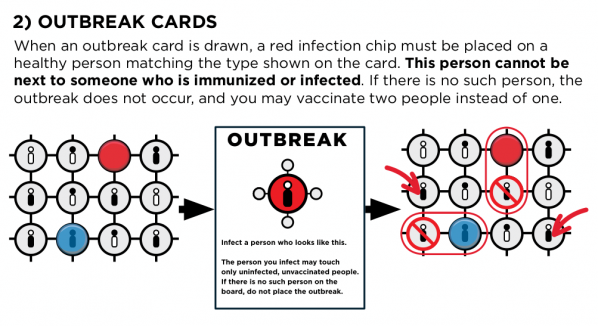
EG: In most games, a competitive element is introduced to result in a ‘winner’ and ‘loser’. POX deliberately avoids this convention, encouraging players to work together in order to stop the virus. Why was the game designed for this mode of play?
MF: One of the ethos of Tiltfactor games is cooperative play. We like to make games in which players can use collaborative strategy. We define collaborative strategy games as those in which:
1. Games (or in some situations, components of games) where if one player reaches the lose state, everyone playing also loses;
2. The extent to which players win is positively correlated to the success of other players.
Often the most interesting games do not fit comfortably into stereotypical models of play. And because we make games about less traditional topics — public health, layoffs, GMO crops, and other political and social challenges –it is important that the game model itself reflect that. In educational scenarios or in community development, games mirror more closely the ways in which people work together to solve problems. So, the reason that POX is a cooperative game are deeply set in the lab ethos towards problem solving — we can only solve problems together.
EG: You are working on a digital version of the game for the iPad. What was your rational for approaching the topic through both a digital and physical platform and do you think these result in a different type of engagement?
MF: Yes — we’re also creating an iPad version and have an online version to launch as well. It is fascinating to make multiplatform games like this– we are a small lab so we’re doing most everything ourselves, including packaging, promotion, and research.
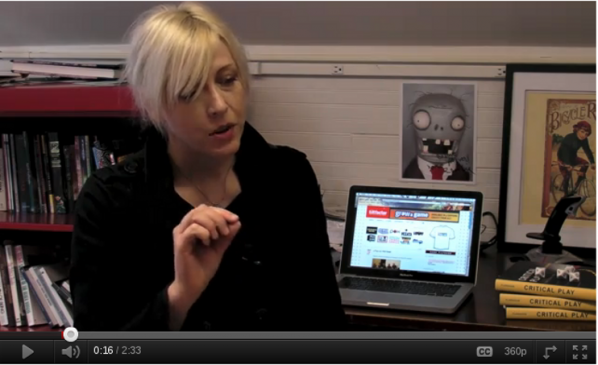
The differences between the platforms for the game are so dramatic, we’ve decided to conduct a study with the same game and different platforms, because watching people play the same game, the same rules, on a different platform clearly results in an different play experience. It is clear to me that very different things are going on, and I want to back up claims with data. For example, players play much faster if the game is computer based via an online game or the iPad. Players seem to like pressing buttons fast. In the board game, for example, observation shows us that players pick up pieces and discuss the moves with the other players, considering this option and that. The game piece actually becomes a kind of thinking object, I don’t know for sure, but it is very different. The speed up in time with a computer-based game appears to cut down conversation and meaningful dialogue that we’ve recorded in our last study on the board game. So, this is something that as games makers we’d really like to understand better, and share with others.
As an artist, I’m known to make media art and works that engage with play and game culture. In the laboratory context, I love developing and researching games with my team. I have amazing people to work with: Sukdith Punjasthitkul is my project manager who has a background in underground Asian culture, public health, and tennis; Zara Downs is a graphic designer and rural hipster who loves biology; Max Seidman is my accomplished undergraduate engineering student who has racked up several games in his time at the lab, and he loves wearing vests. Matt Cloyd is working with me, a recent graduate who is involved in sustainability issues in communities. Erika Murillo is a new student team member obsessed with social issues and animation. The list goes on. Part of the mission of what we do is to help the next generation who care about social issues have the tools to push what we do now, further.
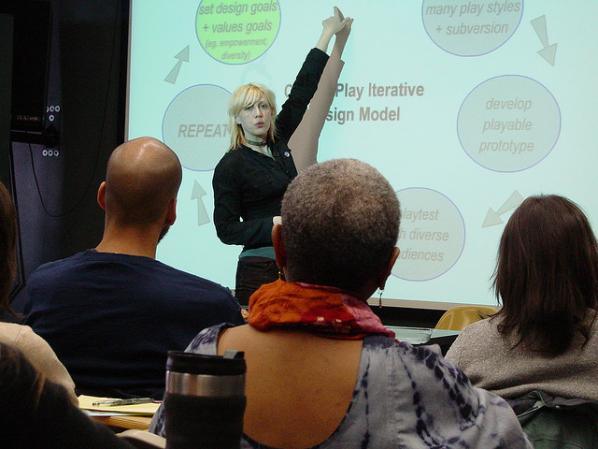
EG: Your point about how you’ve found players to engage more in dialogue when involved in a board game is very interesting. Non digital games such as board games and pervasive urban games have become more popular over the past few years; do you think players are desiring a more socially interactive experience?
MF: Board games are enjoying a renaissance, it is true. First, because I think people really like playing together in a physical space. Perhaps the new technologies — Wii and Kinect — remind people of that. Perhaps they played recently at a family gathering and remembered how much fun they are. It is impossible to say. Second, there are some really well-designed games out there right now, and available in many countries (in part, due to online purchase power), that are certainly worth playing. People do really like playing with each other in physical space, and they still enjoy watching sports in person. Technology can help facilitate this as with mobile games and pervasive games, but it is not a requirement for a good game. I think different kinds of conversations may happen over board games as compared to digital games, but this is something that needs some data behind it. So, we’ll be doing a study on these nuances in my lab very soon.
EG: Looking at Huizinga’s idea of ‘the magic circle’, there is a clear boundary between play and non-play. What were the challenges in designing a game which straddles this boundary, on one hand trying to entice participants through play and interaction, and on the other attempting to create real life social change?
MF: Emilie, this is the riding question for all of game design engaged with social issues, and behind all of the debates on how gamification can incite real behavioural and social change. You’ve hit the nail on the head! There are many forms of play, some which stay within the game in a nice neat package, like our board game, and some that bleed over into real life, such as ARGs. But one should not be fooled into thinking that this means that the former is useless for education and social change, and the latter is obviously better at it. We are about to release our pilot study on the learning in the game, and the results are surprising, showing that learning transfers out of the game as players can apply concepts in the game to new topics. We’re careful researchers. As artists, and as people critical of flippant comments about games and change, we don’t take research lightly. We don’t, for example, cite major gains on attitudinal change and make assumptions on long term behavioural change from a 40-minute game play session. That would be bad science. So we scale our questions accordingly, and in fact, are still surprised and pleased by the effect the game has. I’ll update you on the specifics when the paper is published this autumn!
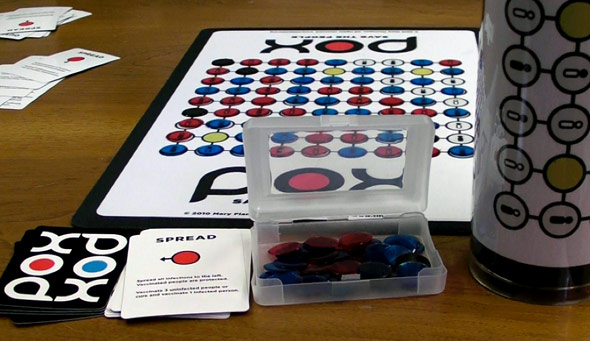
The deeper issues on the limits of how games can incentivise real behavioural and social change can get rather dark. How Pavlovian do we want to be in influencing people? Even those in social change arenas have to pause and think. Education and influence for good is what we strive for. Designers and companies can only go so far before we have something much more sinister at hand. This is why our team’s work on the Values at Play project (http://www.valuesatplay.org) remains relevant.
Featured image: Landscape by Antoinette J. Citizen (2008-2010)
The Italian plumber Mario appeared for the first time in 1981 as a character in the videogame Donkey Kong, created by the famous Japanese game developer Shigeru Miyamoto. Two years later, Mario became the main character of his own game, and his fame grew exponentially. Approximately 200 different videogames have been produced where Mario has the lead role. In contemporary art Mario is also a popular personality and Cory Arcangel is the artist who has done the most famous works based on the videogame.
Super Mario Cloud is probably the most famous of Archangels’ Mario works. It was created in 2002 and was exhibited at the Whitney Biennial 2004. In Super Mario Cloud Arcangel has hacked and changed an old Nintenedo game cartridge so that the only thing that remains of the original game are the little white fluffy clouds that slowly scrolls by on the clear blue sky. Since Arcangel has taken away all of the game elements and interaction you can refer to it as an anti-game. You can also interpret the work as a renewal and a commentary on the art historical genre cloud painting that became popular during the 1800s, when the science of cloud formations and their appearance emerged.
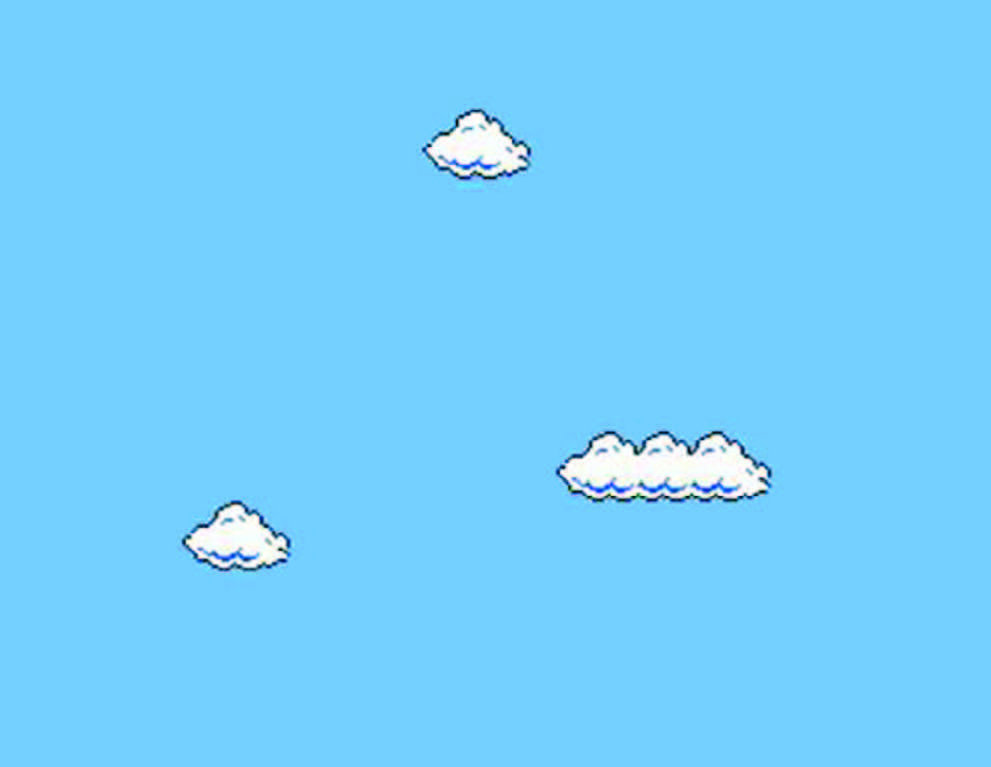
Super Mario Movie is a 15 minute video which Arcangel did together with Paper Rad in 2005. Again, this is a hacked cartridge of a Nintendo, and in the opening scene, you can read the following text:
“As a video game grows old its content and internal logic deteriorate. For a character caught in this breakdown problems affect every area of life.”
For Mario, it means that when his world grows older its graphic content and logic breaks down until he finds himself trapped in a nightmare where he falls head over heels down the screen in a changing fragmented world of psychedelic colours in which, among other things, a giant Mario head pops up. What Arcangel describes is the natural degradation process that eventually affects all physical storage devices from floppy disks, CDs to hard drives. When the stored information is getting corrupt by age it results in misreading with strange and illogical effects on the screen. It’s not just we human that are having problems when our cells and DNA are getting corrupt by age, even game characters could experience strange behaviors and diseases when their data ages.
Video: Naptime by Cori Arcangel (2002)
In the video Naptime (2002) we find Mario sleeping in his bed and above him is a dream cloud that consist of a psychedelic stream of characters and colours – the same effect which you can experience when you try to run old games that have become damaged or are using a computer with a broken graphic card. Just like in Super Mario Movie it seems like a nightmare is chasing Mario in Naptime. It is a world of corrupt code and information in which the game logic has broken down, a world that behaves as if it was infected by a nasty computer virus.
Video: SuperMario Sleeping by Miltos Manetas (1987)
The artist Miltos Manetas has also created a video with a sleeping Mario. In the three-minute long film Super Mario Sleeping (1987) we see how Mario gets tired and lies down and sleeps in the grass. Just as in Arcangel artwork the video is describing an anti-game. All the interactivity and stress in the game are removed and instead we experience a calm and meditative atmosphere. Philip K. Dick novel Do Androids Dream of Electric Sheep? (1968) comes to my mind. What is it that distinguishes a human from an android or a character in a video game? Can characters in computer games dream and, in that case, what are they dreaming of when we are not playing them?
It is now not only the character Mario who is interesting for artists, but also the objects in the game. The Australian artist Antoinette J. Citizen created in 2008 the interactive installation Super Mario Brothers Level 1-1 in which she transformed an art gallery into a Super Mario game. She painted the walls with different levels of the game and installed interactive boxes with question marks and bricks. The visitor could touched the boxes which then produced different sounds from the game. Citizen’s works are, like many other Game Art works, an example of how artists transfer the virtual game world into the real exhibition space.
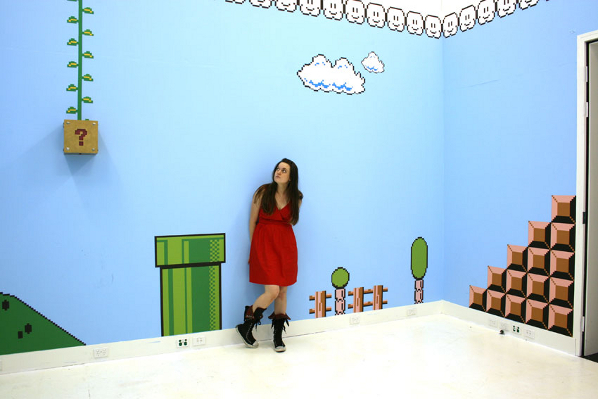
Mario is probably the most famous character in the videogame world. The question is if he is not as famous as Jesus? The Polish artist Kordian Lewandowski plays with the idea in the work Game Over. He has created a copy of Michelangelo’s famous Pieta sculpture but instead of a dying Christ in the arms of the Virgin Mary, we see Mario lying lifeless in the arms of Princess Peach. It seems that videogames with their own iconology and stories about the constant struggle between good and evil, in some degree, have taken over the role of religion when it comes to creating references and cultural contexts for people.
http://www.coryarcangel.com/things-i-made/supermarioclouds/
http://www.coryarcangel.com/things-i-made/supermariomovie/
http://www.artforum.com/video/mode=large&id=25370
http://www.supermariosleeping.com/
http://antoinettejcitizen.com/works/landscape/
http://wielkiartysta.pl/content/index.html
Featured image: Games/03 Paul Sermon, Peace Games, © der Künstler 2008.
Das Spiel und Seine Grenzen: Passagen des Spiels II ed. Mathias Fuchs and Ernst Strouhal, (Springer Verlag, 2010), German language only.
Fuchs, Mathias; Strouhal, Ernst (Hrsg.)
1st Edition., 2010, 272 S. 16 Abb., Softcover
ISBN: 978-3-7091-0084-4
Versandfertig innerhalb von 3 Tagen
Mathias Fuchs is considered to be one of the first artists to explore the combination of videogames and art. Today he is a senior lecture at Salford University in England and a leading researcher on Game Art and ludic interfaces. Social and political context in videogames and how they affect our society has been a major topic in Fuch’s research. Last year he published, together with Ernst Strouhal, an anthology of videogames and its borders and how this genre is changing and influencing society. The background to the anthology was an exhibition held at Kunsthalle Wien in 2008 about art and politics in videogames.
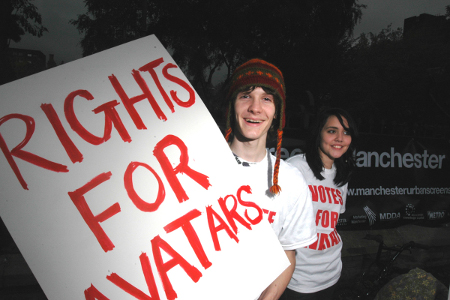
It has been 60 years since Johan Huizinga’s now classic book Homo Ludens, the playing human, was published. Games are no longer just entertainment; it’s a major industry that is affecting our society in every aspect. In the foreword Fuchs states that the main issue for the 15 essays in the anthology is how games have changed and affected our society both politically and socially since they crossed over from the realms of entertainment into everyday experience.
Today we can find many different genres in videogames, such as serious games and persuasive games, that discuss current issues, news and social problems, artistic games which address existential and aesthetic aspects, and so on. The gaming community has grown enormously and created on-line worlds with strong virtual economics, attached real world economics. In her essay Daphne Dragona says “The virtual environments of our times therefore can be seen as social institutions with social, political and economic values resembling those of real life.”
In a similar way Tapio Mäkelä’s essay about locative games describes how the gamescene has entered the real world in the form of cos-players and social gameplays where videogames as Pacman are performed in the city streets or games as “/Noderunner/, where participants run to find open WiFi Networks, take a photo of themselves at the location and send the info via e-mail to the project’s website.” This begins to close the gap between networks and everyday experience through the practice of social gaming. The game as object is less of an obvious conclusion now that technology enables us to explore ourselves within networked, gaming contexts and mobile technologies.
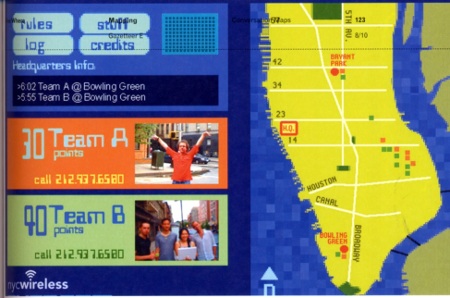
The borders between game and reality have now become even more blurred and integrated, especially if we consider how technology itself also crosses over into administrational activites which have already been traditional elements of controlling, processing parts of our lives. One example is how authorities around the world are supervising these new socio-economics, such as collecting taxes from virtual incomes by using similar tools and networks. There are many questions about how games will continue to affect and change our society in the future and the anthology takes an interesting and comprehensive look into what games have to offer and what could be potential threats to our future societies.
Today games are serious business. It is not impossible that in the future a bankruptcy of an on-line gameworld could shake the real world and create an economic depression. On the other hand, could on-line game economies bring prosperity and create new jobs, an economic boom in ways we have not witnessed before? If games move into a new period of changing social experience in even more connected ways than before, then we need to understand what the consequences of these are and how to navigate through this shifting terrain. One thing is for sure, it was a long time ago that games were just entertainment.
http://www.springer.com/new+%26+forthcoming+titles+%28default%29/book/978-3-7091-0084-4
Editors Ruth Catlow, Marc Garrett, Corrado Morgana.
Digital games are important not only because of their cultural ubiquity or their sales figures but for what they can offer as a space for creative practice. Games are significant for what they embody; human computer interface, notions of agency, sociality, visualisation, cybernetics, representation, embodiment, activism, narrative and play. These and a whole host of other issues are significant not only to the game designer but also present in the work of the artist that thinks and rethinks games. Re-appropriated for activism, activation, commentary and critique within games and culture, artists have responded vigorously.
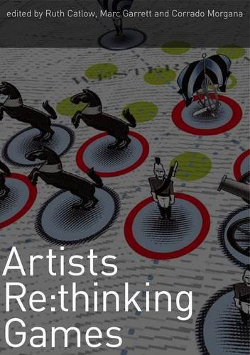
Over the last decade artists have taken the engines and culture of digital games as their tools and materials. In doing so their work has connected with hacker mentalities and a culture of critical mash-up, recalling Situationist practices of the 1950s and 60s and challenging and overturning expected practice.
This publication looks at how a selection of leading artists, designers and commentators have challenged the norms and expectations of both game and art worlds with both criticality and popular appeal. It explores themes adopted by the artist that thinks and rethinks games and includes essays, interviews and artists’ projects from Jeremy Bailey, Ruth Catlow, Heather Corcoran, Daphne Dragona, Mary Flanagan, Mathias Fuchs, Alex Galloway, Marc Garrett, Corrado Morgana, Anne-Marie Schleiner, David Surman, Tale of Tales, Bill Viola, and Emma Westecott.
In collaboration with FACT – http://www.fact.co.uk
http://www.furtherfield.org
http://www.http.uk.net/
Publisher: Liverpool University Press (31 Mar 2010)
Language English
ISBN-10: 1846312477
ISBN-13: 978-1846312472
http://www.amazon.co.uk/gp/offer-listing/1846312477
Ruth Catlow, Marc Garrett, Corrado Morgana
Come and celebrate with Furtherfield.org the recent publication of ‘Artists Re: Thinking Games’.
This is an unmissable event for all artists/gamers with a presentation by respected game artist Dr Mary Flanagan, a guest appearance by Jeremy Bailey and a display of some of the gameart featured in the book as well as an introduction by the editors.
Corrado Morgana – About the book.
Ruth Catlow & Marc Garrett – Extra Context.
Guest Speaker – Mary Flanagan.
Guest Appearance – Jeremy Bailey.
Food and drink will be served.
At Birkbeck University of London’s Cinema
43 Gordon Square
Birkbeck, University of London.
London WC1H 0PD
Time 2pm – 4.30pm
Thursday June 10th 2010.
RSVP – contact ruth.catlow@furtherfield.org
Editors Ruth Catlow, Marc Garrett, Corrado Morgana.
Digital games are important not only because of their cultural ubiquity or their sales figures but for what they can offer as a space for creative practice. Games are significant for what they embody; human computer interface, notions of agency, sociality, visualisation, cybernetics, representation, embodiment, activism, narrative and play. These and a whole host of other issues are significant not only to the game designer but also present in the work of the artist that thinks and rethinks games. Re-appropriated for activism, activation, commentary and critique within games and culture, artists have responded vigorously.
Over the last decade artists have taken the engines and culture of digital games as their tools and materials. In doing so their work has connected with hacker mentalities and a culture of critical mash-up, recalling Situationist practices of the 1950s and 60s and challenging and overturning expected practice.
This publication looks at how a selection of leading artists, designers and commentators have challenged the norms and expectations of both game and art worlds with both criticality and popular appeal. It explores themes adopted by the artist that thinks and rethinks games and includes essays, interviews and artists’ projects from Jeremy Bailey, Ruth Catlow, Heather Corcoran, Daphne Dragona, Mary Flanagan, Mathias Fuchs, Alex Galloway, Marc Garrett, Corrado Morgana, Anne-Marie Schleiner, David Surman, Tale of Tales, Bill Viola, and Emma Westecott.
In collaboration with FACT – http://www.fact.co.uk
http://www.furtherfield.org
http://www.http.uk.net/
Publisher: Liverpool University Press (31 Mar 2010)
Language English
ISBN-10: 1846312477
ISBN-13: 978-1846312472
http://www.amazon.co.uk/gp/offer-listing/1846312477